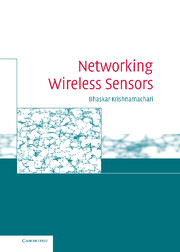Book contents
- Frontmatter
- Contents
- Preface
- 1 Introduction
- 2 Network deployment
- 3 Localization
- 4 Time synchronization
- 5 Wireless characteristics
- 6 Medium-access and sleep scheduling
- 7 Sleep-based topology control
- 8 Energy-efficient and robust routing
- 9 Data-centric networking
- 10 Transport reliability and congestion control
- 11 Conclusions
- References
- Index
10 - Transport reliability and congestion control
Published online by Cambridge University Press: 14 August 2009
- Frontmatter
- Contents
- Preface
- 1 Introduction
- 2 Network deployment
- 3 Localization
- 4 Time synchronization
- 5 Wireless characteristics
- 6 Medium-access and sleep scheduling
- 7 Sleep-based topology control
- 8 Energy-efficient and robust routing
- 9 Data-centric networking
- 10 Transport reliability and congestion control
- 11 Conclusions
- References
- Index
Summary
Overview
The objective of transport layer protocols is to provide reliability and other quality of service (QoS) services and guarantees for information transfer over inherently unreliable and resource-constrained networks. The following are the interrelated guarantees and services that may be needed in wireless sensor networks:
Reliable delivery guarantee: For some critical data, it may be necessary to ensure that the data arrive from origin to destination without loss.
Priority delivery: The data generated within the WSN may be of different priorities; e.g., the data corresponding to an unusual event detection may have much higher priority than periodic background readings. If the network is congested, it is important to ensure that at least the high-priority data get through, even if the low-priority data have to be dropped or suppressed.
Delay guarantee: In critical applications, particularly those where the sensor data are used to initiate some form of actuation or response, the data packets generated by sensor sources may have strict requirements for delivery to the destination within a specified time.
Energy-efficient delivery: Energy wastage during times of network congestion must be minimized, for instance by forcing any necessary packet drops to occur as close to the source as possible.
Fairness: Different notions of fairness may be relevant, depending on the application. These range from ensuring that all nodes in the network provide equal amounts of data (e.g. in a simple data-gathering application), to max– min fairness, to proportional fairness.
- Type
- Chapter
- Information
- Networking Wireless Sensors , pp. 165 - 178Publisher: Cambridge University PressPrint publication year: 2005

